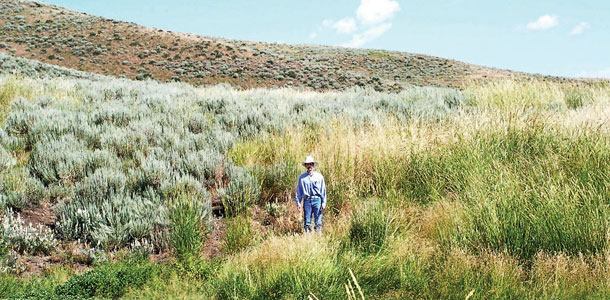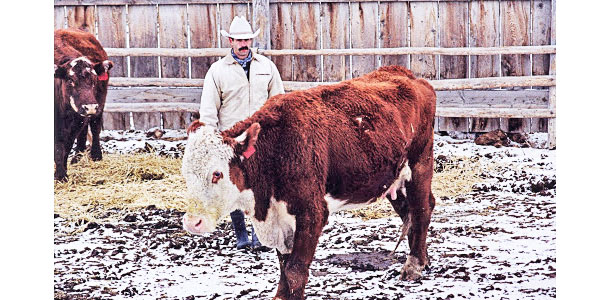The late Bud Williams was the father of low-stress cattle handling, teaching people how to move cattle in better ways.
Steve Cote, recently retired district conservationist (Natural Resources Conservation Service, Arco, Idaho), has done a lot of work on handling range cattle using low-stress stockmanship as a tool to place cattle in desired locations on the range.
Handling cattle is no different from handling or training a horse. “When I was young, the way we broke horses was rough on the horse,” he says.
Today it’s more acceptable to handle horses (and cattle) with less stress and more tact, working with the animals’ natural tendencies instead of against them. “Natural horsemanship” is similar to low-stress stockmanship.

How it began
Cote first tried this type of cattle handling when he was working with the Morgan Creek Grazing Association. “They asked me to help because I was the district conservationist at Challis at that time and knew the range.
I soon realized that neither the Forest Service nor the ranchers knew what to do to resolve the issues, which included overuse of riparian areas.
The administrative actions demanded that the ranchers do something different, but no one knew what to do different. They were already riding as hard as they could, trying to keep the cattle in acceptable areas. They’d worn out a lot of horses,” he says.
“A rancher friend, Anita Pratt, heard about Bud Williams and about holistic management – how to plan grazing and rotational grazing.
I’d listened to Allan Savory and thought he made sense, but how do you do that on rangeland with no fences? You can’t put electric fences out there, because wildlife tear it down and string it around,” says Cote.
“Anita wondered about doing it with dogs to keep the herd together and out of the riparian areas. That became an unworkable idea, however, with the introduction of wolves.”
They kill the dogs and also get the cattle so stirred up and frantic that they are no longer amenable to herding with dogs.
“There were not too many cattle; there were just some that would quit the bunch and hang out in riparian areas. There was plenty of feed, but the Forest Service thought the cattle were overusing some areas and had to move.
At first I got mad at the Forest Service – and then realized they were under their own pressures from environmentalists,” he says.

So Cote attended a Bud Williams school and learned handling cattle the right way allows them to come together as a herd and stay wherever you put them. “If we could combine that technique with good collaborative planning, it would work,” says Cote.
The ranchers had 1,300 pairs but only about 60 that were a problem. Even though the riders kept pushing them out of the riparian areas, they came back.
“Williams explained that it was because of the stress on the cattle. He showed me how to handle that situation. I went home and practiced with 200 pairs. Within the first day, I had it working. I got a drive started and cut the front quarter of the herd off.
I just walked up the side and slowed down all the rest and cut off the front and let them go over the hill. Those front ones are the more sensitive ones, and I didn’t know how to deal with those yet,” he says.
“I worked with the rest by myself in a pasture across from my house, where I could watch them. They stayed all day in the spot I put them.
They would go to the canal and drink, and then go back to the herd. I used my neighbor’s herd summer after summer, perfecting this, and ran a pasture rotation without fences,” says Cote.
“What we did on Morgan Creek was hire a rider. I worked with him a couple of months and he had it figured out. There were no longer individual animals that would quit the bunch and go into the riparian areas,” says Cote.
How it works
Handling cattle this way is like putting a training foundation on a horse. “Many cattle are stressed when we approach. So we make sure they respond well to everything we need them to do.
With range cattle, we need them to get mothered up, keep their calves with them and be able to go straight ahead at a good walk. They need to be able to turn as a herd, slow down and stop. There are techniques for doing this without stressing cattle,” he explains.
“If you want a cow to go, you use pressure and release, like you would with a horse. Cattle want to be a herd, but they also don’t want to be stressed when they are in the herd.” If they are being stressed by a rider, they won’t relax and be comfortable in the herd.
“We handled them with no stress, no force – like you would do with a horse. I never force a horse to do something. It has to be their idea to do it.
As soon as they do it, they have release of pressure. If I walk up to a cow to pressure her to go forward, if she spins around and to face me (because cattle want to see what’s pressuring them), she’s not ready yet. So then I just relax around that cow until she’s ready.”
Then he pressures that cow to walk forward. As she moves that way less pressure is applied and she realizes it’s OK to continue.
“I pressure her gently from the side, or back and forth – depending on what she needs to get her moving,” Cote says. “It’s very important to do straight lines.
If you’ve watched a good dog work cattle, it goes back and forth behind the herd in straight lines, and pretty soon the herd will line out.
All too often, the person following a herd will curve up the side. Then the corners turn in, the cows are no longer mothered, and they are upset.”
When getting an animal to walk straight ahead with good movement, you may try to pressure her again soon as she slows down. But this time you can be farther away. Soon she’ll get the idea to keep going. Then her movement attracts other animals to go with her.
“I encourage ranchers to practice before they turn out, teaching cattle to drive as a herd,” he says. “You can work cattle from the lead – on foot, on horseback or with a four-wheeler – and have a dog or person bring up the rear. Cattle really like to follow a leader; they go so much better than being driven from behind.”
He also suggests using three people to drive cattle. The person in the middle goes back and forth in straight lines, or zigzags if needed. Soon the more sensitive cows line out, and the back ones flow in and follow.
“The rider on the left controls movement if the herd needs to turn to the right. The rider would go more toward the left to increase pressure on that side of the herd, and the rider in the middle backs off a little, and the herd can swing.
It’s like a wagon; the outside tire has to move farther than the inside tire. The rider on the right backs way off, and then the whole herd makes the pivot and stays mothered.”
When you first start driving pairs, you may get them unmothered, but to resolve this you let them drift and stop.
“If I have to, I walk up the sides and slow them to let them get mothered. If they are unmothered and bawling for their calf, they will be stressed,” he explains.
You can place cattle where you want them in the mountains and keep the riparian areas from being overgrazed. “Once the cattle are up there, they settle in. You need to show them water, so they know where it is. Then you can leave them where you want them and take all the movement out of the herd and let them settle,” says Cote. ![]()
For more information go to Bud Williams’ website or the Stockmanship Journal website edited by Whit Hibbard.
PHOTOS
PHOTO 1: One key objective in range corrals is to practice before turnout.
PHOTO 2: Steve Cote shows riparian areas restored through careful cattle movements.
PHOTO 3: Pressure cattle at the right angle side to prompt forward motion. Photos courtesy of Steve Cote.







